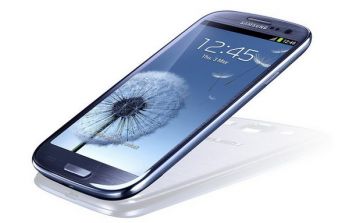PenTile RGBG matrix technology explained
Samsung's Pentile matrix technology is a sub-pixel design architecture family. The basic PenTile structure is the RGBG matrix. In RGBG PenTile displays there are only two subpixels per pixel, with twice as many green pixels than red and blue ones. You can see a PenTile matrix vs a Real-Stripe one on the images below (the PenTile is on the right):
The Pentile technology was commercialized by Clairvoyante. In March 2008, Samsung bought the company's PenTile related IP and technology, and formed a new company called Nuovoyance to continue development of this display technology. Here's an image from Nuovoyance showing Pentile vs RGB matrix (which they call a 'legacy' matrix):
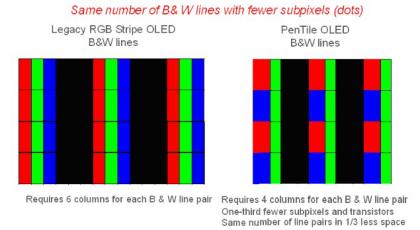
PenTile relies on the human eye design - if you reduce the number of blue subpixels, you barely reduce the image quality. There are other advantages to PenTile displays (for example longer liftime, which will be explained below). But even Samsung admits that a real-stripe RGB matrix is better than Pentile, for example here's some marketing image from Samsung showing how a non-Pentile display (the Super AMOLED Plus) is better than the pentile Super AMOLED:
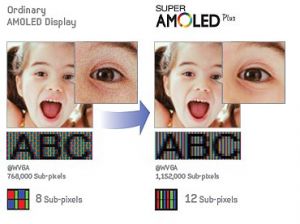
Some people indeed do not like PenTile displays. Mostly it seems because there is a visible pattern when you look at the display up close. Your eyes get used to this pattern quickly though, and the higher resolution the display is, the less visible the pattern is. Modern PenTile OLED displays reach very high pixel densities that make it virtually impossible to notice the patern.
Samsung's AMOLED and Super AMOLED displays
Samsung uses PenTile technology in virtually all of their Super AMOLED displays, which are used in most of the company's smartphones - including the Galaxy S7 and S7 edge.
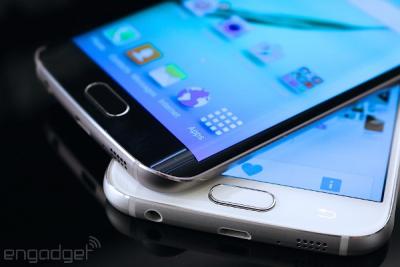
Diamond Pixel Pentile
Samsung's latest Super AMOLED displays adopt a new subpixel arrangement called Diamond Pixel. The first phone to use this pentile type was the Galaxy S4 (later phones adopted a slightly different Diamond pattern). In a Diamond Pixel display, there are twice as many green subpixels as there are blue and red ones, and the green subpixels are oval and small while the red and blue ones are diamond-shaped and larger (the blue subpixel is slightly larger than the red one). The diamond shapes were chosen to maximize the sub-pixel packing and achieve the highest possible PPI. The greens are oval because they are squeezed between the larger red and blue ones.
![]()
Pentile displays last longer
One of the advantages of PenTile displays is that they last longer. In fact today this is one of the major reasons Samsung are using PenTile for high-resolution (over 230 ppi) OLEDs. Read here for Nuovoyance (Samsung's company in charge of PenTile) explanation.
Further reading
The latest Pentile news:
Does the Galaxy Note 2 use Ignis' AdMo-p technology?
Yesterday I posted about the Galaxy Note 2 subpixl scheme, with the 5.5" 1280x720 HD Super AMOLED display featuring 267 ppi (with three subpixels per pixel). Our readers pointed out that the new scheme used in the Note 2 looks very much like Ingis Innovations' patented HR pixel structure (as part of their AdMo-p technology). This may explain how Samsung managed to get good enough lifetime at such a high PPI without PenTile.
![]()
Just as a reminder, here's how the Note 2 pixels are arranged. It's not exaclty the same as in the HR structure as the red and green sub-pixels have the same size. In any case:
The Galaxy Note 2 uses a non-pentile OLED display at 267 PPI
When Samsung announced the Galaxy Note 2, with its 5.5" 1280x720 HD Super AMOLED display, I assumed it was a Pentile display. But it seems that the Note 2 actually uses an RGB matrix in a unique arrangement (see the photo below). Samsung calls this new matrix S-Stripe. This is rather confusing on several accounts - mostly because up till now Samsung used the brand Super AMOLED Plus for non-pentile OLEDs.
![]()
Just a few weeks ago we explained that Pentile OLED displays enable higher lifetime, and we were told that for an RGB OLED with over 230 PPI, lifetime becomes too low for Samsung and they choose Pentile in those displays. But the Note II has a PPI of 267 - the highest PPI non-Pentile OLED. This means it has a lower lifetime compared to a Pentile display (but the advantage is that there's no visible Pentile pattern of course).
Samsung announces the Galaxy Note II: 5.5" glass-based Super AMOLED HD (1280x720) display
Samsung announced the successor to the popular "Phablet" Galaxy Note, the Note 2 - with a 5.5" HD Super AMOLED display (1280x720, non-Pentile). Yes - this is a 'regular' glass based AMOLED panel, and not a plastic-based flexible YOUM panel as earlier rumors suggested. I guess we'll have to wait some more for Samsung's first flexible-OLED device, due in 2012 (it'll probably have a much smaller panel).
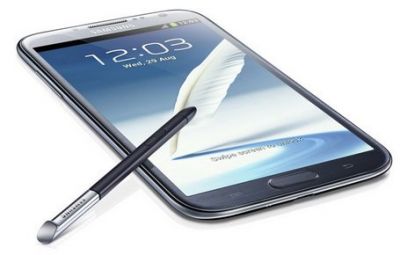
Nouvoyance explains why PenTile OLEDs last longer
A few months ago Samsung said that the new Galaxy S3 has a Pentile display (a 4.8" 1280x720 HD Super AMOLED one to be exact) because PenTile increased the lifetime of OLED panels. I have discussed this with Joel Pollack, an Executive VP at Nouvoyance (Samsung's company that developed the PenTile matrix scheme), and he explains this claim further.
An OLED display is made from colored (RGB) sub pixels. A blue OLED has the lowest luminous efficiency (lower then red and green) and so needs to be driven at higher current - which means a lower lifetime.
Samsung's Galaxy SIII now shipping from AT&T for $189.99
According to Amazon, the Galaxy S3 is now shipping for AT&T for $189.99 (including a contract of course). I think that's the first carrier to actually ship this phone in the US. The Galaxy S3 US model has a 4.8" 1280x720 HD Super AMOLED (with Pentile), a dual-core 1.5Ghz CPU, 2GB of RAM and an 8 mp camera (1080p video) and lot's of new software features. The phone weighs 133 grams and is only 8.6 mm thick.
The S3 pre-order numbers were very strong, and it seems that Samsung has another winner at their hands, we'll be sure to hear from Samsung about actual sales numbers soon.
Samsung - we keep using PenTile AMOLED displays because they last longer
Update: We discussed this with Nuovoyance's VP, he explains better why PenTile displyas lasts longer...
Some people really dislike Pentile displays, but Samsung keep producing AMOLED with PenTile - even in their flagship devices such as the new Galaxy S3 (which sports a 4.8" 1280x720 HD Super AMOLED). Today we hear that Samsung says that one of the major advantages of PenTile AMOLED displays is increased lifetime.
In PenTile displays, there are twice as many green subpixels as there are blue suxpixels. Blue OLEDs feature the lowest lifetime, and so Pentile displays "tend" to last longer, according to Samsung. In any case, as the resolution gets higher, it's getting harder to actually notice the "fuzziness" caused by the Pentile Matrix...
Samsung announces two new digital cameras with AMOLED displays
Samsung announced two new cameras today, and both of them has the same display: 3" VGA AMOLED (with PenTile). The NX20 is Samsung's flagship interchangeable lens camera. It has 20.3 mp APS-C CMOS sensor, has a built-in SVGA EVF, Wi-Fi, Full-HD video and the ISO range is up to 12,800.
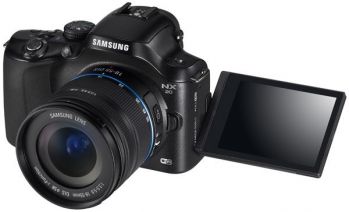
The second camera, the NX210 is a minor upgrade to the NX200: it adds Wi-Fi and a tweaked image sensor. Other features stay the same - a 20.3 mp sensor, Full-HD videos and the same AMOLED display.
LGD: our IPS-LCD offers better power consumption and color accuracy than OLEDs
LG Display is touting their 4.5" True HD IPS-LCD display (which does not support Full-HD, mind you, the resolution is 1,280x720). The company posted some slides comparing the HD IPS-LCD display to Samsung's Super AMOLED HD (as used in the Galaxy Nexus and other devices). LG Display says that the LCD is more sharp and clear (due to the Real Stripe matrix vs the Pentile one used in Samsung's AMOLED):
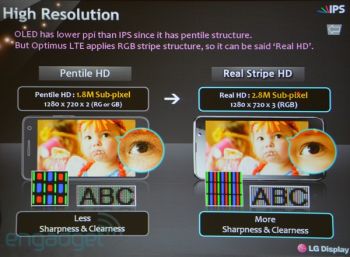
The Galaxy Nexus now shipping in the UK
Samsung's Galaxy Nexus is now shipping in the UK (with a contract). It will be available sim-free on December 2nd, for £519 (you can pre-order now). The Galaxy Nexus is the first Android v4 (Ice Cream Sandwich) smartphone. It features a 4.65" HD Super AMOLED display (1280x720, using PenTile technology) with a curved glass, a dual-core 1.2Ghz CPU, Full-HD video encoding, 5nmp camera, NFC, 1GB of RAM and 16/32GB of internal memory.
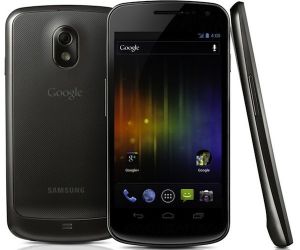
Samsung announces a Korean Galaxy S II variant with a Super AMOLED HD display
Samsung announced two new Galaxy SII variants - both with LTE, and both for the Korean market. The more interesting one is the Galaxy S II HD LTE which offers a 4.65" Super AMOLED HD display - offering 1280x720 resolution (316ppi, most likely with Pentile). The second phone is the Galaxy S II LTE which has a 4.5" 480 x 800 display (207ppi).
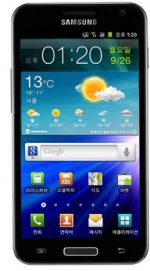
Beside the display, both phone feature LTE of course, a 1.5Ghz dual-core processor, 8mp camera (1080p video), 16GB of internal memory, Wi-Fi, GPS and NFC.
Pagination
- Previous page
- Page 3
- Next page


